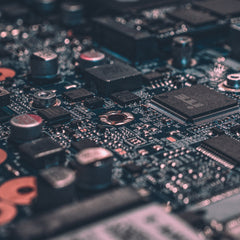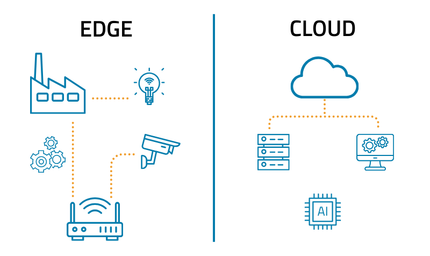In IoT system design, one of the most important architectural decisions is where data should be processed and stored. The choice between edge computing and cloud infrastructure directly affects performance, security, scalability, and cost. For many organizations, the real answer is not purely one or the other, but understanding the strengths and limitations of each.
The Role of Edge Computing in IoT
Edge computing for IoT processes data closer to the devices where it originates, using gateways, microcontrollers, or embedded processors. Instead of sending raw data upstream, edge devices filter, summarize, and act on information locally.
Technical benefits of IoT edge computing:
-
Ultra-low latency: By eliminating network round trips, decisions can be made in milliseconds. This is critical for robotics, machine vision, and industrial safety systems.
-
Optimized bandwidth usage: Edge nodes can transmit only processed results or flagged anomalies, preventing overload of constrained networks such as LTE-M, NB-IoT, or LoRaWAN.
-
Local reliability: Edge processing continues to function even if the cloud connection is lost, which is valuable in environments with intermittent connectivity.
-
Security controls at the device layer: Data can be encrypted, filtered, or anonymized before leaving the edge.
Business considerations for edge computing:
-
Lower bandwidth costs by reducing how much data is transmitted.
-
Faster responsiveness creates measurable ROI in environments like manufacturing, where avoiding downtime leads to significant savings.
-
Edge deployment requires upfront investment in hardware and firmware maintenance, which may increase operational complexity.
The Strengths of Cloud IoT Solutions
Cloud IoT solutions excel at centralization and scale. By moving data into a shared infrastructure, businesses gain access to vast compute power, flexible storage, and integrated services.
Technical benefits of IoT cloud architecture:
-
Scalability without physical limits: Cloud platforms can ingest millions of device messages per second.
-
Advanced analytics and AI integration: Running machine learning models on large data sets is easier in the cloud, where compute and GPU resources are abundant.
-
Cross-location visibility: Data from globally distributed IoT deployments can be aggregated for enterprise-level decision-making.
-
Protocol translation and integration: Cloud systems often support a range of IoT protocols (MQTT, CoAP, HTTP, OPC UA), simplifying multi-vendor interoperability.
Business considerations for cloud computing:
-
Pay-as-you-go pricing models reduce the need for large capital investments in infrastructure.
-
Centralized management lowers the burden of maintaining distributed compute resources.
-
Data residency and compliance regulations may require careful planning, especially in healthcare or finance.
Edge vs. Cloud: Making the Right Choice
The trade-off between edge and cloud IoT depends on three factors: performance requirements, data sensitivity, and scalability.
Edge-first scenarios:
-
Real-time production monitoring where milliseconds prevent costly downtime
-
Industrial automation systems requiring high availability with limited connectivity
-
Smart energy systems that must balance loads instantly
Cloud-first scenarios:
-
Consumer IoT platforms with millions of endpoints
-
Applications where long-term historical data analysis drives value
-
Use cases where integration with enterprise IT systems is a priority
Hybrid approaches:
Many organizations combine both. Edge devices provide immediate responsiveness and data reduction, while the cloud stores historical data, runs predictive models, and manages device fleets at scale. This model balances operational efficiency with business intelligence.
Technical Trade-offs to Consider
-
Latency tolerance: If your application can tolerate seconds instead of milliseconds, cloud may suffice.
-
Data volume: High-frequency sensor data is often too large to transmit continuously; edge filtering becomes necessary.
-
Compute constraints: Edge devices are limited by processing power and energy consumption, while cloud can scale almost infinitely.
-
Connectivity: Stable broadband or 5G enables more cloud reliance, while remote sites may need edge-heavy designs.
Business Trade-offs to Consider
-
Total cost of ownership: Cloud reduces upfront capital expenditure but can incur high recurring costs as data scales. Edge requires more hardware investment but may reduce cloud bills over time.
-
Compliance and security: Highly regulated industries often prefer edge processing to keep sensitive data on site.
-
Future scalability: Cloud platforms allow easier global expansion, while edge deployments may need to be re-architected for growth.
How Grid Connect Helps You Decide
At Grid Connect, we guide organizations through these architecture decisions. Our team designs IoT solutions that balance edge computing for faster decision-making with cloud IoT solutions for scalability and analytics. We also help define hybrid strategies where local processing reduces latency and bandwidth usage, while cloud systems handle deeper analysis, reporting, and device management.
Choosing where your IoT data lives is both a technical and business decision. The right architecture ensures your IoT deployment is not only functional today but also adaptable for tomorrow’s demands.
Ready to explore IoT connectivity solutions for your business? Contact Grid Connect today.







